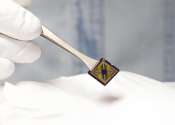Research team develops absolute taste 'electronic tongue' technology
A research team led by Professor Kyung-In Jang at the Department of Robotics and Mechanical and Electronic Engineering, DGIST, and another led by Professor Jihwan Choi at the Department of Aerospace Engineering, KAIST, developed ...
Dec 27, 2023
0
6









